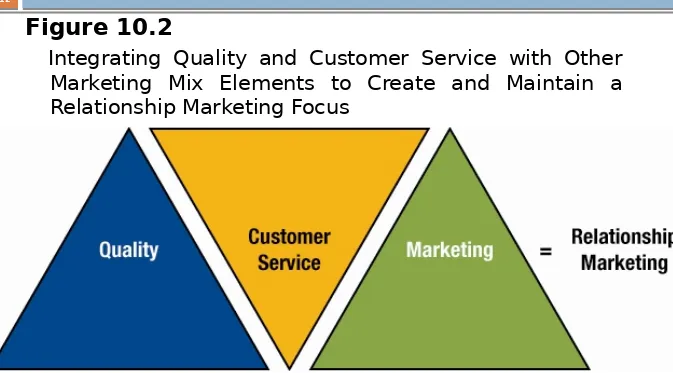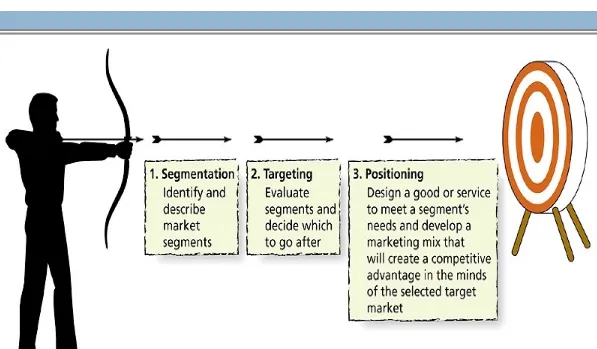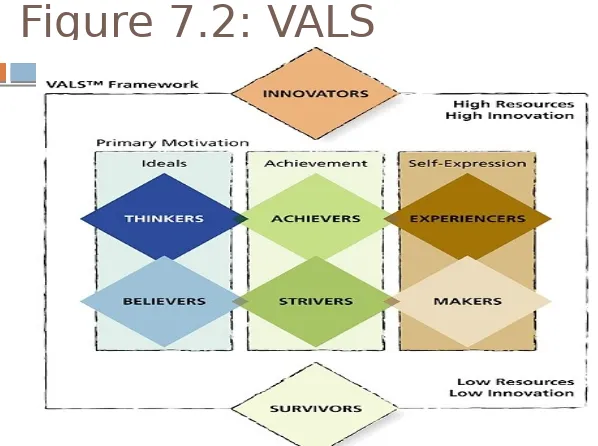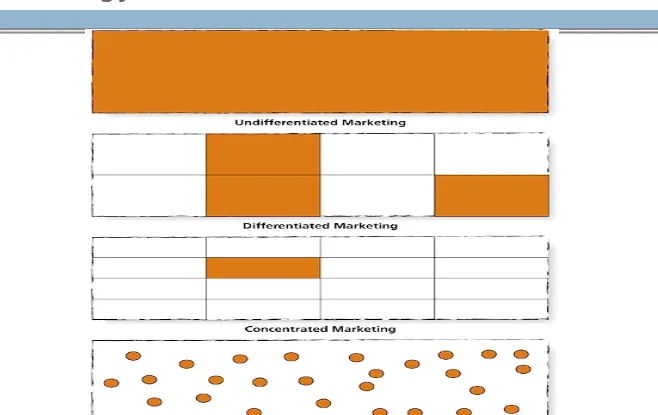RELATIONSHIP
MARKETING DAN CRM
Sales System
Sales
System Marketing System Marketing
System Customer Service System Customer Service System Collaborat ive CRM Collaborat
ive CRM werehouseData
Data
werehouse MiningData Data Mining
Back Office – Analytical CRM
Front Office – Operational CRM
CRM Programs Can Potentially
Improve
What does CRM involve?
CRM involves the following :
Organisations must become customer
focused
Organisations must be prepared to adapt
so that it take customer needs into account and delivers them
Market research must be undertaken to
Face-to-face CRM
CRM can also be carried out in face-to-face
interactions without the use of technology
Staff members often remember the names and
favourite services/products of regular customers and use this information to create a personalised service for them.
For example, in a hospital library you will know the
name of nurses that come in often and probably remember the area that they work in.
However, face-to-face CRM could prove less useful
Customer Relationship Management is about making every customer as valuable as possible over the lifetime of the relationship
Customer Relationship Management is about making every customer as valuable as possible over the lifetime of the relationship
The Five Key Drivers of the Lifetime Value of a Customer
Cost of Targeting;
Cost of Acquisition;
Service and Usage Revenue;
Cost of service; and
Pertanyaan
1. Sebutkan para perusahaan yang
The Shift from Transaction-Based Marketing to Relationship Marketing
10-8
Transaction-based marketing
Buyer and Seller exchanges characterized
by limited communications and little or no ongoing relationship between the parties
Relationship marketing
Development and maintenance of
long-term, cost-effective relationships with
10-9
Customer relationship
management
The combination of strategies and
tools that drive relationship
10-10
Forms of
Buyer-Seller
10-11
Comparing Transaction-Based
10-12
Figure 10.2
10-13
Making a
Promise to Customers
The small
print promises
that Gore-Tex
10-14
Internal marketing
Managerial actions that help all
members of the organization understand and accept their respective roles in
implementing a marketing strategy
The Relationship Marketing Continuum
10-15
First Level: Focus on Price
Second Level: Social Interactions
Third Level: Interdependent
10-16
Three Levels of Relationship
Marketing
Characteristic Level 1 Level 2 Level 3
Primary bond Financial Social Structural
Degree of
customization Low Medium Medium to high
Potential for sustained competitive advantage
Low Moderate High
10-17
Chi-Chi’s
Using
Financial Incentives
10-18
The First
Level of
10-19
Developing a
Social
Relationship
With Customers
American
Airlines’
custom published magazine
communicates with its
Second Level
Social Interactions
10-20
Dry Cleaner chats with customers
Art Gallery host receptions -
“Thursday Night” in Portland
Auto Service Department – calls
after a repair
Your business – “Special Customer
Night”, take to dinner, send birthday, holiday cards
[Need to develop a data base]
Third Level
Interdependent Partnership
10-21
Supplier manages the customer’s
inventories
Supplier owns the customer’s
inventories
Food Broker supplies sales
specialists [CROSSMARK/Cadbury Adams]
Manufacturers have customer
Enhancing Customer Satisfaction
10-22
Three
Building Buyer-Seller
Relationships
10-23
Many customers are seeking ways
to simplify their lives, and
relationships provide a way to do this
Customers find comfort with brands
that have become familiar through their ongoing relationships with
companies
Such relationships often lead to
more efficient decision-making my customers and higher levels of
10-24
How Marketers Keep Customers
Retaining customers as far more
profitable than losing them
Customers typically generate more
profits for firm with each additional year of the relationship
It has been noted that a 5 percent gain in
customer retention can lead to an 80 percent increase in profits
Frequency marketing – Mileage Plus
Affinity marketing – sponsor’s name on
10-25
Frequency
marketing:
Marriott
10-26
Database marketing
Benefits include:
Selecting the best customers
Calculating the lifetime value of their business
Creating a meaningful dialogue that builds genuine loyalty
Interactive television
Application service providers (ASPs)
10-27
One-to-One marketing – customized to
build long-term customer relationships
Grassroots marketing – use of
non-mainstream channels like unique events [new dishwasher soap introduction in laundromats for Hispanic/Latino consumers]
Viral marketing [analogous to the spread of a
pathological or computer virus] –
refers to the idea that people will pass on
and share interesting and entertaining content.
Uses pre-existing social networks to
produce increases in brand awareness
Customer Relationship Management
10-28
The combination of strategies and
tools that drive relationship
programs, reorientating the entire
organization to a concentrated focus on satisfying customers
Managing Virtual Relationships
[Online to consumers and/or business customers]
Retrieving Lost Customers
Buyer-Seller Relationships in
Business-to-Business Markets
10-29
Business-to-business marketing involves
an organization’s purchase of goods and services to support company operations or the production of other products
Buyer-seller relationships between
companies involve working together to provide advantages that benefit both parties
Advantages might include the lower
prices, quicker delivery, improved quality and reliability, customized product
10-30
Choosing Business Partners
Partnership: an affiliation of two or more
companies to assist each other in the achievement of common goals
Types of Partnerships
Buyer partnership – buyer has unique needs
that must be met
Seller partnerships – seller develops
long-term relationships
Internal partnerships – within the company
itself
Lateral partnerships – with other compatible
10-31
Cobranding and Comarketing
Improving Buyer-Seller Relationships in Business-to-Business Markets
10-32
National Account Selling
Business-to-Business
Databases [Sales Discovery System]
Electronic Data Interchange
Quick-response merchandising
Vendor-Managed Inventory
(VMI)
Collaborative planning, forecasting,
and replenishment
10-33
Business-to-Business
Alliances
Resources and Skills That Partners
Contribute to Strategic Alliances Skills
Patents
Product lines Brand equity Reputation
- For product quality - For customer service - For product innovation Image
- Company wide - Business unit - Product line/brand Knowledge of
product-market
Customer base
Marketing resources
- Marketing infrastructure Sales force size
Established relationship with: - Suppliers
- Marketing intermediaries - End-use customers
Manufacturing resources - Location
- Size, scale economies, scope economies, excess capacity, newness of plant and equipment
Information technology and systems
Marketing Skills
- Innovation and product development
- Positioning and segmentation - Advertising and sales
promotion
Manufacturing Skills - Miniaturization
- Low-cost manufacturing - Flexible manufacturing Planning and implementation skills
R&D skills
Organizational expertise, producer learning, and experience effects
Evaluating Customer Relationship Programs
10-34
Lifetime value of
customer: the revenues and
intangible benefits that a customer
brings to the seller over an average
lifetime, less the amount of money which must be
10-35
Additional techniques used to evaluate
relationship programs include:
Tracking rebate requests, coupon
redemptions, credit-card purchases, and product registrations
Monitoring complaints and returned
products and analyzing why customers leave
Reviewing reply cards, common forms,
and surveys
Monitoring "click-through" behavior on
Hopefuls Gird for Gridiron
Little-Known Firms Bet on Maximum Super Bowl Impact
36
Buying Super Bowl ads has helped catapult companies like online brokerage
E*Trade Financial, Internet job board Monster.com and video site Hulu into the public eye. That's why several little-known advertisers—including mobile pay-TV firm Flo TV, information provider KGB and vacation rental service HomeAway.com— are forking over millions of dollars to appear on this year's Big Game broadcast. Flo TV, which will be pitching a pocket-size device for watching TV on the go, has
enlisted CBS Sports commentators James Brown and Jim Nantz in one of its spots, which features a man unable to watch the game because he is stuck shopping for bras with his wife.
KGB, which answers consumer questions via text message for 99 cents a apiece, is still deciding which ad it will run. One possibility shows actors William Baldwin and Stephen Baldwin jumping out of a plane, while another features two women trying to find a clown to appear at their kids' birthdays. The mom who doesn't use KGB ends up with a not-so-lovable clown.
Real People, Real Choices
37
Reebok (Que Gaskins)
How to capture the pulse of youth
culture in the long run?
Option 1: mimic Nike’s moves with Michael
Jordan
Option 2: build on Reebok’s success with
Iverson, while separating the brand from other performance sneaker brands like Nike
Option 3: maintain the Iverson emphasis
Target Marketing Strategy: Selecting and Entering a Market
38
Market fragmentation: The creation of
many consumer groups due to the diversity of their needs and wants.
Target marketing strategy: dividing the
Figure 7.1: Steps in the Target Marketing Process
Step 1: Segmentation
40
The process of dividing a larger market
into smaller pieces based on one or
more meaningful shared characteristics
Segmentation variables: dimensions that
Segmenting Consumer
Markets
Segmentation
variables can slice up the market
Demographic,
psychological, and behavioral
differences
Segmenting by Demographics
Age: Generational Marketing
Children
Teens/tweens
Generation Y: born
between 1977 and 1994
Generation X: born
between 1965 and 1976
Baby boomers: born
between 1946 and 1964
Older consumers
Segmenting by Demographics
Gender
Many products appeal
to one sex or the other
Metrosexual: a man
who is heterosexual, sensitive, educated, and an urban dweller in touch with his
feminine side
Segmenting by Demographics (cont’d)
44
Family Structure
Income
Social Class
Race and Ethnicity
African Americans
Asian Americans
Hispanic Americans
Segmenting by Geography
45
Geodemography: combines geography
with demographics
Geocoding: Customizes Web advertising
so people who log on in different places see ad banners for local businesses
Segmenting by
Psychographics
46
Psychographics: The use of
psychological, sociological and
anthropological factors to construct market segments.
AIOs: Psychographics segments
Figure 7.2: VALS
Segmenting by Behavior
48
Segments consumers based on how they
act toward, feel about, or use a product
80/20 rule: 20 percent of purchasers
account for 80 percent of a product’s sales
Heavy, medium, and light users and
nonusers of a product
Usage occasions
Segmenting Business-to-Business Markets
49
By organizational demographics
By production technology used
By whether customer is a user/nonuser
of product
By North American Industry
Step 2: Targeting
50
Marketers evaluate the attractiveness of
each potential segment and decide in
which they will invest resources to try to turn them into customers
Target market: customer group(s)
Evaluation of Market
Segments
51
A viable target segment should:
Have members with similar product needs/
wants
Be measurable in size and purchasing
power
Be large enough to be profitable
Be reachable by marketing communications
Have needs the marketer can adequately
Developing Segment
Profiles
52
Need to develop a profile or description
of the “typical” customer in a segment.
Segment profile might include
Choosing a Targeting
Strategy
53
Undifferentiated targeting: appealing to
a broad spectrum of people
Differentiated targeting: developing one
or more products for each of several customer groups
Concentrated targeting: offering one or
Choosing a Targeting Strategy (cont’d)
54
Custom marketing: tailoring specific
products to individual customers
Mass customization: modifying a basic
Figure 7.3: Choosing a Target Marketing Strategy
Step 3: Positioning
Developing a marketing strategy aimed at
influencing how a particular market segment perceives a good/service in comparison to the competition
Steps in Developing a
Positioning Strategy
1. Analyze competitors’
positions.
2. Offer a good/service with
competitive advantage.
3. Match elements of the
marketing mix to the selected segment.
4. Evaluate target market’s
responses and modify strategies if needed.
Positioning (cont’d)
58
Repositioning: redoing a product’s
position to respond to marketplace changes.
Retro brand: a once-popular brand that
has been revived to experience a
The Brand Personality
59
A distinctive image that captures the
brand’s character and benefits
Perceptual map: a picture of where
Ideal Points
Customer perceptions
Aggregation of individuals
Distributions around points
Different shapes
Optimal points, vectors
Segment variations
Evolutionary progression
Preference Models
Ideal points
(individuals)
Clusters
(segments)
In general ...
Most of a brand’s sales will come from
the segments with the closest ideal points
Most of a segment’s sales (share) will go
Targeting Strategies
Direct hit …
single product ‘right on’
Bracketing
multiple products ‘surround’
“Tweeners”
• Coors Popular with Men Heavy Special Occasions
Dining Out Premium
Popular with Women Light Pale Color On a Budget
Good Value Blue Collar
Customer Relationship Management (CRM)
65
Sees marketing as a process of building
long-term relationships with customers to keep them satisfied and coming back.
Four Steps in One-to-One Marketing
66
Identify customers; know them in as
much detail as possible.
Differentiate customers by their needs
and value to the company.
Interact with customers; find ways to
improve the interaction.
Customize some aspect of the products
CRM: A New Perspective on an Old Problem
67
CRM systems use computers, software,
databases, and the Internet to capture information at each touch point between customers and companies, to allow
better customer care.
CRM proposes that customers are
Characteristics of CRM
68
Share of customer (vs. share of market)
Lifetime value of the customer
Customer equity
Real People, Real Choices
69
Reebok (Que Gaskins)
Que chose option 2: build on Reebok’s
success with Iverson, while separating the brand from other performance
sneaker brands like Nike
Reebok created a new category called Rbk
Pertanyaan
1. Pilihlah dan jelaskan iklan dari
perusahaan yang berbasis di Indonesia yang menunjukkan
Ketiga levell dari Relationship Marketing
Segmentasi Pasar
The Players
The Top 11 CRM Manufactures Are:
Company Product name
1. Microsoft Microsoft Dynamics CRM 3.0 2. Sage Software SalesLogix CRM 3. SAP America Inc. SAP Business One CRM 4. Parature Inc. Parature 5. Entellium Entellium CRM 6. Pivotal corp. Pivotal CRM 7. Maximizer Software Maximizer Enterprise CRM 8. Netsuite Inc. NetSuite CRM+ 9. Oncontact Software Oncontact V 10. ADAPT Software Applications ADAPT crm 11. Exact Software North America e-Synergy



